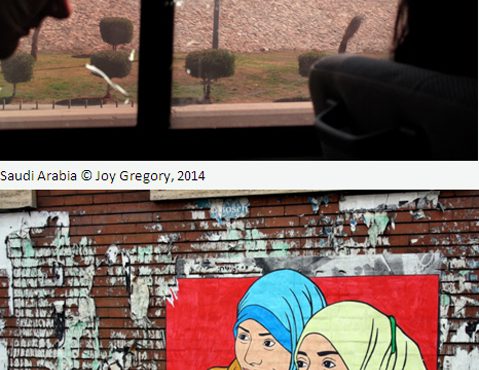- Venue
Stuart Hall Library
-
Time
6:30pm
-
Admission
Free
- Artists
Audio recordings of the event are available at the bottom of the page
Joy Gregory : The Veil in Saudi Arabia
Artist Joy Gregory will introduce a new body of work that looks at the wearing of the veil in Saudi Arabia. Joy Gregory’s photographic practice addresses anthropological themes arising from her ongoing research interest in visual forms of documenting cultural differences in contemporary society.
Previous work includes the video piece Gomera which engaged with the relationship between language and the environment with particular emphasis on issues around language endangerment. Another ongoing project, Sites of Africa is a photographic document of absent histories, tracing London’s connections with the African continent today.
Biography
Joy Gregory is an internationally recognised and award-winning artist. Prominent within her field, she has always taken a cross-disciplinary approach to her work and the vehicle of photography- she is an artist of ideas constantly pushing the boundaries of the medium. Joy Gregory was born in 1959 in Bicester, Oxfordshire. She studied Communication Art and Design at the Manchester Polytechnic and Photography at the Royal College of Art. Her work included in many collections including the UK Arts Council Collection, Victoria and Albert Museum, Institute of Modern Art, Brisbane, Australia, and Yale British Art Collection. She currently lives and works in London.
Pina Sadar : Hijab Couture
Fuelled with political and media preoccupation with the subject, the Islamic veil has become one of the most controversial sartorial items of contemporary British milieu. The polemics are not limited to political sphere but stretch into wardrobes, high streets, and catwalks. Especially in the aftermath of 9/11, the hijab has exceeded the status of a solely religious symbol and has become consciously incorporated into everyday and high fashion with an aim to communicate messages of resistance, belonging, feminism or personal difference. This paper explores diverse attitudes of British Muslim women towards the place of the hijab in fashion and observes how women incorporate, negotiate and appropriate the hijab in their everyday style. In addition, the paper focuses on the popularisation of the hijab as a fashion item or even a costume and examines how Muslim women perceive the phenomenon of ‘hijab tourism’ as exhibited in pop culture, marketing industry and by non-Muslim women. The paper combines personal experiences of British Muslim women with fragments from media and social media texts and contextualises them from the perspective of anthropology of fashion.
Biography
Pina Sadar is a third year PhD student and teaching assistant in Socio-Cultural Anthropology at Durham University. Her interests include visual anthropology, feminism and multiculturalism
Halima Khanom and Saif Osmani contributed with descriptions of their projects on Muslim women’s dress and the story of muslin cloth.



